Analysing Refraction of Waves
- Figure shows a surfer approaching the beach. As the waves enter the shallow water near the beach, the wavelength of the waves decreases. Hence, the speed of the waves decreases as the water gets shallower.
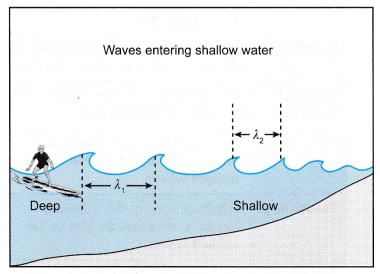
- Refraction of waves is a phenomenon that occurs when there is a change of direction in the propagation of waves travelling from one medium to another due to a change of speed.
- The refraction of water waves occurs when water waves travel from one area to another area of different depths. Hence, the different depth of water is equivalent to a different medium.
People also ask
- Analysing Reflection of Waves
- Analysing Interference of Waves
- Analysing Diffraction of Waves
- Analysing Sound Waves
- Analysing Electromagnetic Waves
Characteristics of Refraction of Waves
Figure shows the refraction of water waves travelling from a deep area to a shallow area.
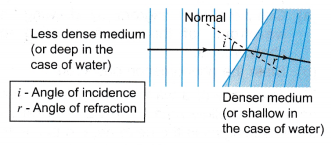
- Direction: The direction of the propagation of waves changed after refraction.
- Angle of refraction: When waves propagate from a less dense medium to a denser medium, the angle of refraction is lesser than the angle of incidence.
- Wavelength: The wavelength of the refracted waves in the denser medium is shorter (as in the case of water, shallower depth is equivalent to denser medium).
- Frequency: The frequency of the waves remains unchanged.
- Speed: The speed of the waves in the denser medium is less than that in the less dense medium.
Refraction of Plane Waves Experiment
Aim: To study the characteristics of refraction of plane waves in a ripple tank.
Material: White paper as screen
Apparatus: Ripple tank with its accessories, stroboscope, trapezium-shaped perspex plate, convex-shaped perspex plate, concave-shaped perspex plate
Method:


- The ripple tank is arranged as shown in Figure.
- The legs of the ripple tank are adjusted so that the base of the tank is horizontal. The tank is filled with water.
- A trapezium-shaped perspex plate is placed in the tank to create a shallow area as shown in Figure.
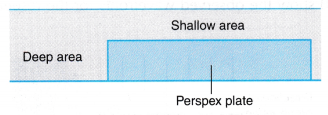
- A horizontal vibrating beam is used to create plane (straight) waves.
- The speed of the motor is adjusted to produce a train of waves that can be clearly observed on the screen with the help of a stroboscope.
- The position of the perspex plate is adjusted with its edge parallel and then at an angle with the vibrating beam. For each case, the wavefronts at the deep and shallow areas of the tank are observed.
- The trapezium-shaped perspex plate is replaced with the convex-shaped perspex plate and then with the concave-shaped perspex plate. For each case, the wavefronts are observed at the deep and shallow areas of the tank.
Observations:



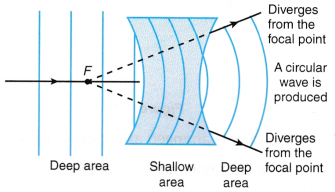 The above Figures show the observed wavefronts for the respective perspex plates.
The above Figures show the observed wavefronts for the respective perspex plates.
Discussion:
- When water waves travel from a deep area to a shallow area as in Figure, the direction of the waves is refracted towards the normal.

- Therefore, the angle of incidence, i of the water waves is greater than the angle of refraction, r.
- When water waves travel from an area into another of different depths, their speeds vary. The frequency of the waves which is equal to the frequency of the motor remains unchanged.
- Figure shows plane water waves travelling from a deep area to a shallow area. Using the formula v = fλ, where vd = fλd and vs = fλs, f remains unchanged. Since λd > λs, therefore, vd > vs The wave speed at the deep area, vd is greater than the wave speed at the shallow area, vs.
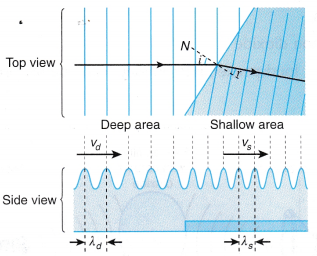
Refraction of Light Experiment
Aim: To study the characteristics of refraction of light.
Material: White paper
Apparatus: Glass block, ray box, power supply, protractor
Method:
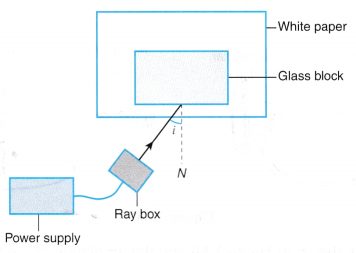
- The apparatus is set up as shown in Figure.
- A ray of light is directed at an angle of incidence, i = 300 to the glass block.
- The ray that enters the glass block is observed and the angle of refraction, r is measured.
- Steps 2 and 3 are repeated for angles of incidence, i = 450 600 and 750.
Observation:
It is observed that when a light ray travels from air into the g ass block, it is refracted towards the normal.
 Discussion:
Discussion:
- Glass is a denser medium than air. A light ray travels at a slower speed in glass compared with in air.
- When a light ray travels from a less dense medium to a denser medium and the ang e of incidence, i is not zero, then the angle of incidence, i is greater than the angle of refraction, r.
Refraction of Sound Waves Experiment
Aim: To study the characteristics of refraction of sound waves.
Material: Balloon filled with carbon dioxide
Apparatus: Audio signal generator, loudspeaker, microphone, cathode ray oscilloscope (C.R.O.)
Method:

- The apparatus is set up as shown in Figure.
- The C.R.O. settings are adjusted to detect the sound waves emitted from the loudspeaker.
- The position of the microphone is adjusted by moving it nearer to the balloon or further away from it until the biggest amplitude of the waves is displayed on the screen.
- The balloon is removed as shown in Figure and the amplitude of the trace displayed on the screen is observed and compared with that observed in step 3.

Observation:
- In step 3, the amplitude of the trace displayed on the screen is bigger than that in step 4.
- This shows that a louder sound is detected when a balloon is placed between the loudspeaker and the microphone.
Discussion:
- When the screen of the C.R.O. displays a trace of bigger amplitude for a sound wave, it indicates a louder sound is detected. This shows that the balloon which is filled with carbon dioxide has focused the sound waves emitted from the loudspeaker to the microphone.
- From the observation, the sound waves that travel through ordinary atmospheric air (less dense medium) to carbon dioxide (denser medium) undergo refraction.
